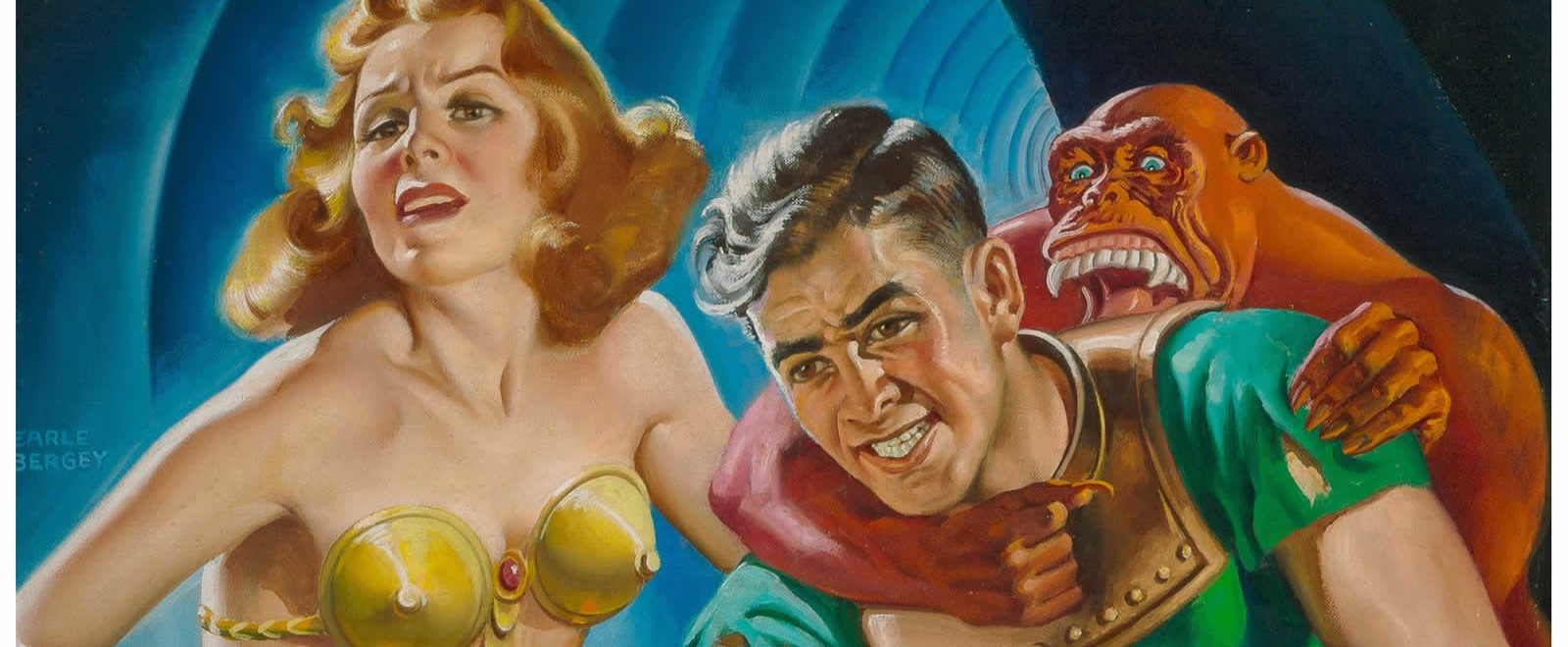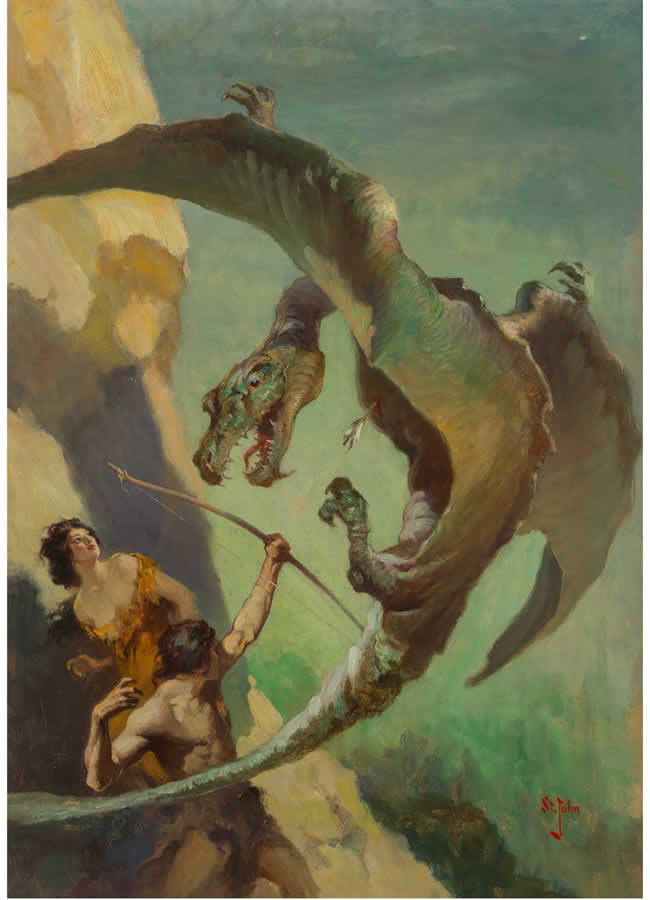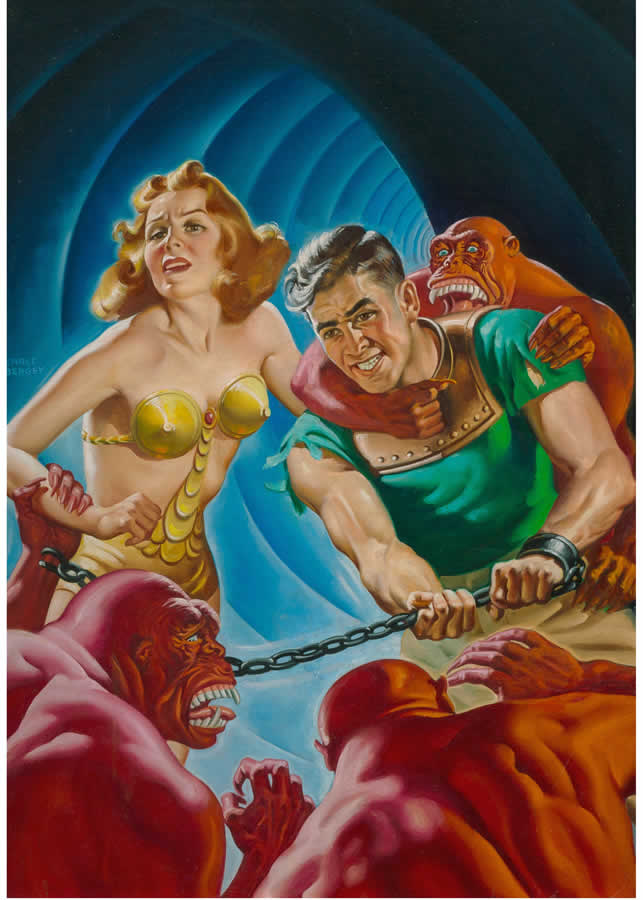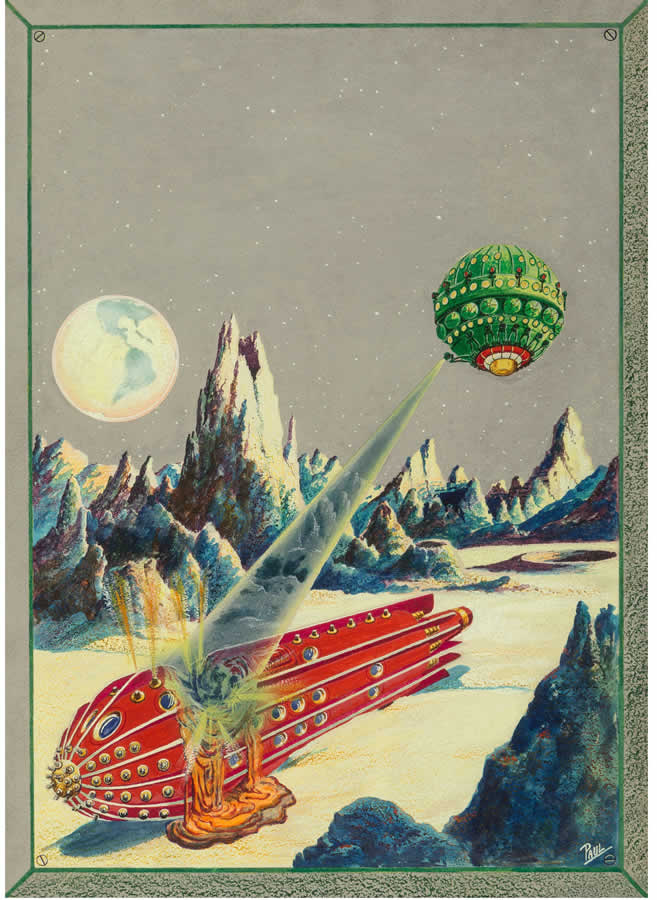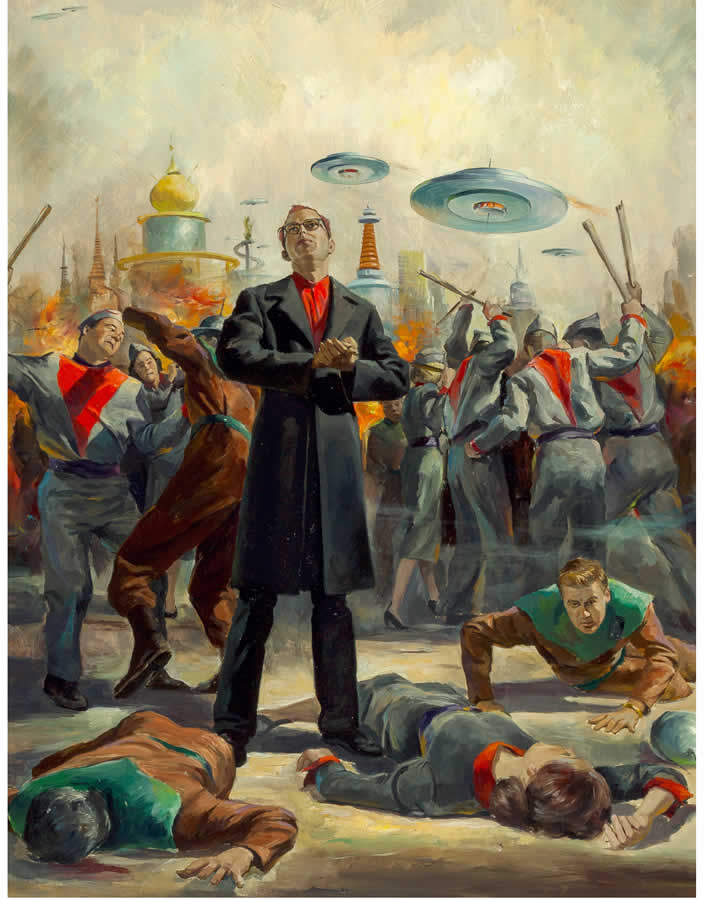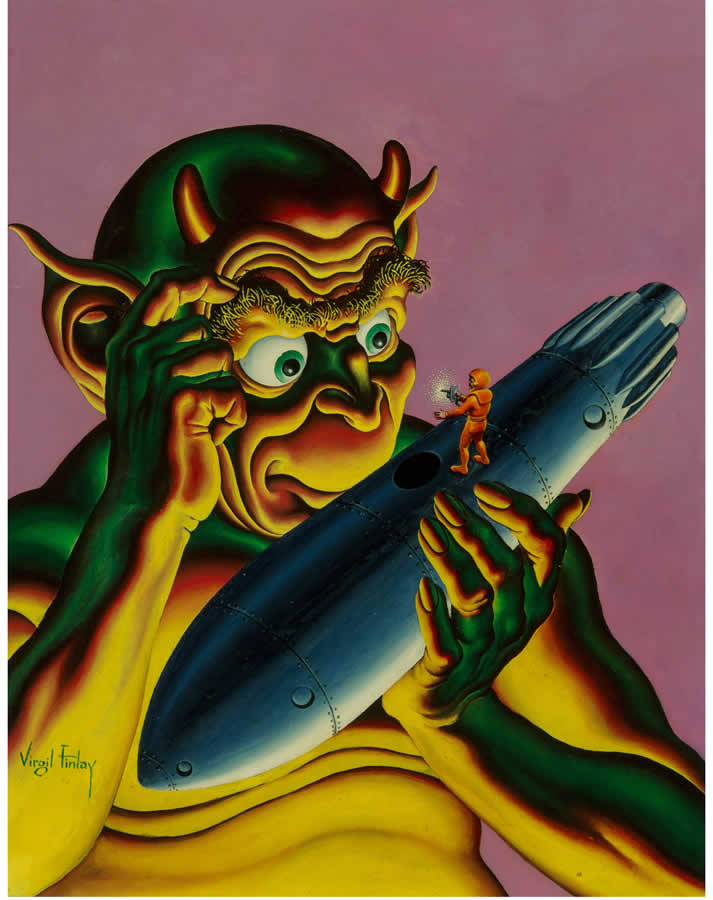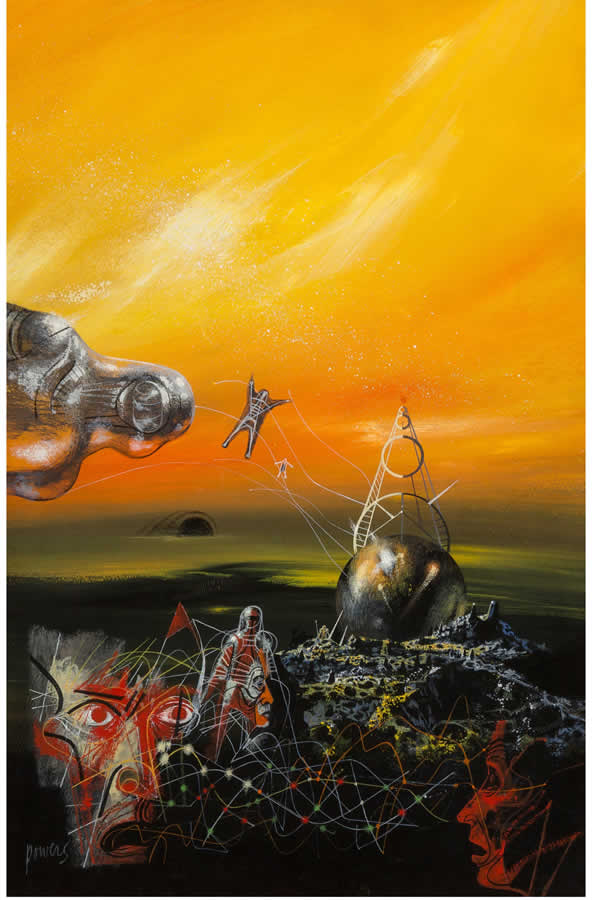NOTED COLLECTOR GLYNN CRAIN AUCTIONING HIS INCREDIBLE PAINTINGS AND BOOKS – FOUR DECADES AFTER EMBARKING ON HIS REMARKABLE JOURNEY
Interview by Hector Cantú
If Glynn Crain has a tip, it is don’t ignore late-night phone calls. Especially if you are a collector.
EVENT
THE GLYNN AND SUZANNE CRAIN SCIENCE-FICTION COLLECTION SIGNATURE® AUCTION 5442
Aug. 13-14, 2019
Live: Dallas
Online: HA.com/5442a
INQUIRIES
Todd Hignite
214.409.1790
ToddH@HA.com
Crain vividly recalls the evening several years ago that he and his wife came home from the movies. “It was about 10 o’clock and a friend of mine had left a message. ‘Hey Glynn, give me a call when you get a chance.’ I didn’t call him back until the next evening. I didn’t think there was any urgency. Well, there was urgency and when he couldn’t get ahold of me, he picked up the phone and called someone else and the painting sold instantly.”
The friend’s find was a painting by famed illustrator Stanley Meltzoff, who in the 1950s created dozens of covers for novels by science-fiction author Robert Heinlein and others. “[Meltzoff] influenced a host of illustrators that came later,” Crain says, “people like Paul Lehr, Vincent Di Fate, and on and on. He’s revered. It was a painting I would dearly love to have, a fantastic example.
Enlarge
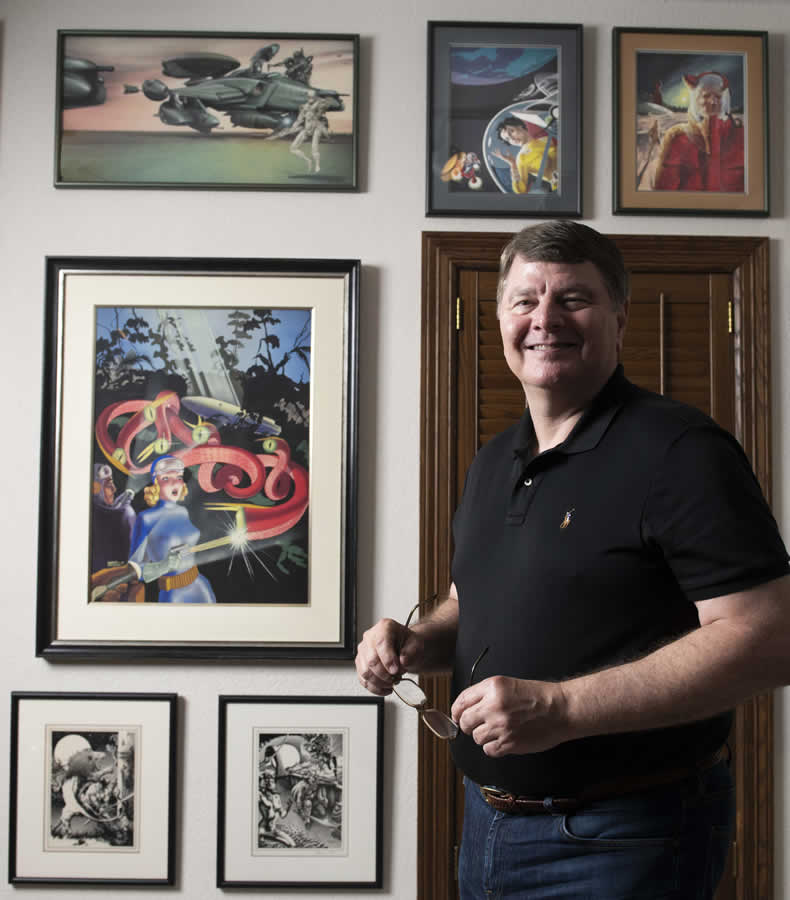
“It’s in a good home now,” says Crain, 63, who knows the collector who acquired the painting. “But that was definitely the one that got away. There’s a saying: ‘You don’t regret the art you buy. You regret the art that you don’t buy.’ For some reason, you thought it was too expensive or you just couldn’t come to terms with the person who had it or the timing wasn’t right or maybe you didn’t have the money. It’s always the things you pass on that you really regret. That was something I learned quickly.”
Not to worry. The former beer distributor from San Antonio still managed to pull together one of the top collections ever of science-fiction. More than 300 illustrations, pulps, comics and rare books from the Glynn and Suzanne Crain Science-Fiction Collection are being offered in August by Heritage Auctions.
“Mid-century American science-fiction art features some of the most iconic and resonant imagery ever created in the illustration field,” says Heritage Auctions Vice President Todd Hignite. “The Glynn and Suzanne Crain Collection is simply the finest and most extensive assemblage of this original artwork to ever come on the market.”
Fellow San Antonio resident John Picacio calls Crain a “master curator” whose collection is “one of the finest and most inspiring any of us will ever see in this lifetime.
“My favorite memory of Glynn’s house,” says Picacio, a Hugo Award-winning illustrator who’s contributed art for George R.R. Martin’s A Song of Ice and Fire series, “is sitting in his library, surrounded by a visual symphony of Whelan and St. John originals, bronze sculptures, coffee-table art tomes, and floor-to-ceiling book shelves. It was nirvana. I’m envious of any collector who is acquiring a piece of this collection. You’re not just owning a piece of science-fiction/fantasy art history, you’re taking home a slice of heaven.”
We talked to Crain about his collecting – from his earliest days to his decision to leave Texas for a new home in Kentucky, which, of course, explains the downsizing.
I was looking at your collection. It’s a who’s who of science-fiction illustration art. Frank Frazetta, John Berkey, Virgil Finlay, Michael Whelan, Bernie Wrightson, J. Allen St. John, Frank R. Paul, Boris Vallejo, Wally Wood. How would you describe the collection in your own words?
Basically, it’s science-fiction art. I started collecting comics as a child, 6 or 7 years old, Marvel Comics, that whole, typical thing. As I got older, I became interested in science-fiction … The Lord of the Rings, which isn’t science-fiction but literature of the fantastic, and I always loved science-fiction stories and I started collecting science-fiction hardbacks. Being a collector is just in your blood. And once you find a liking for something, you start collecting it, then you want to have all the issues or all the books. I eventually became a pretty serious science-fiction collector, from the standpoint of books … hardback books, paperback books, the pulps, the digests, even movie posters, all things science-fiction. So … you have the covers that the stories were given and you start finding that [original cover art] is available. You start collecting them and it just evolved from there.
What was the first piece you remember buying?
As far as science-fiction art, it was a Frank R. Paul painting. It’s in the auction. It’s a Wonder Stories cover.
What were the circumstances of acquiring that piece?
I had been a big EC science-fiction art collector and one of my contacts was [Hollywood screenwriter] Mark Carducci and I really wanted a Frank R. Paul painting because he’s really the father of science-fiction art. If you study the field, back in the ’20s, he basically laid down the template of what science-fiction art was with his covers for Amazing Stories, and you would run across those Amazing Stories in the occasional comic shop. There’d be a rack in the back and they would have various pulps for sale and Frank R. Paul’s Amazing Stories covers just caught my eye. And I’m thinking, “Man, these things are beautiful.” I started buying some of the pulp issues and I realized I really wanted to own one of his paintings.
Do you remember the year this happened?
This would have been the ’80s, the mid-’80s. It took a while to find [art] like that, but eventually I found someone who actually, he didn’t tell me at the time, but he knew [magazine editor and a founder of science-fiction fandom] Forrest J Ackerman. “Forry” at that point in his life was willing to part with some things. Mark put us together and I bought my first science-fiction color painting. It was a Frank R. Paul cover from Wonder Stories and that was the beginning.
Enlarge
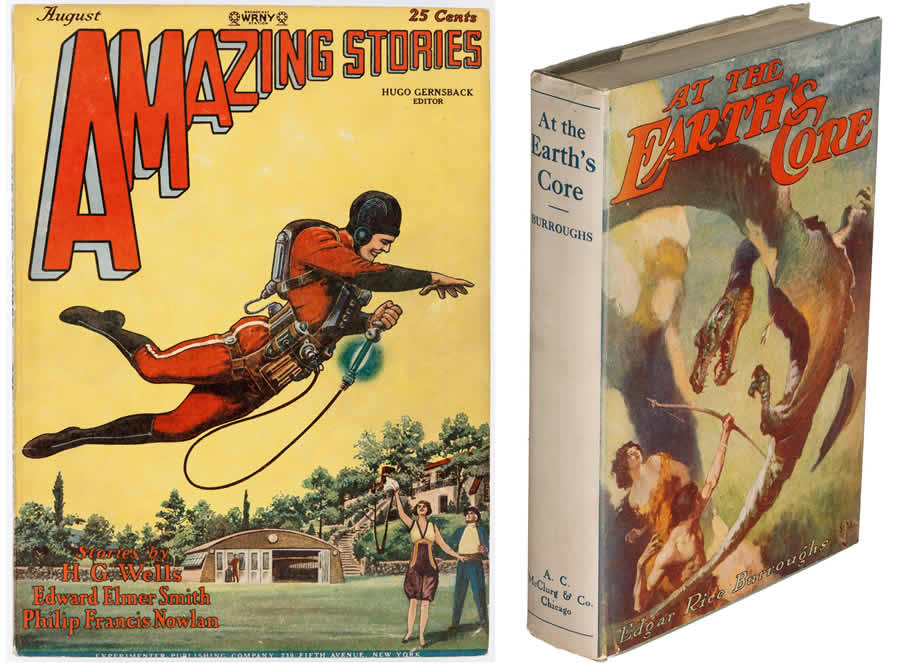
How did you meet people like Ackerman and Carducci?
By going to conventions, comic cons, things like that. When you go to San Diego Comic-Con, you run into all types of collectors and all types of material and you can easily find connections that lead you either into movie paper or to art or books, pulps, comics. It was all there, especially back in the day when San Diego Comic-Con was truly a comic convention.
So San Diego Comic-Con played an important role for you?
Oh, yeah, meeting so many people. Absolutely. You’d run into every dealer and every major collector. At the time, I was also collecting Flash Gordon Sunday strip art by Alex Raymond. I was collecting Krazy Kat by George Herriman. I was collecting EC art by everybody from Wally Wood to Al Williamson, Frank Frazetta paintings, the whole gamut. You could find anything you wanted at Comic-Con. Another really good contact was [publisher] Russ Cochran because he was selling off EC Comics art for [EC publisher] Bill Gaines. So there were so many different connections that you would make, going to conventions like that and meeting people.
Was San Diego your first comic con experience?
No. You have to go back to my high school and college years. The first time I purchased artwork of any kind, it was at a Houston comic convention. I bought [an original] daily comic strip from Russ Cochran for $50. That would have been 1973. I was a senior in high school and every summer we would go to the Houston con. San Diego was bigger, but we couldn’t afford to go to San Diego that early on! Shortly thereafter, I bought a couple of Barry Smith Conan pages. It was at that point that I started realizing, “Wow, this artwork is out there! You can find it. You can buy it. You can own it and you can collect it.”
So you transitioned from comic art to sci-fi illustrations…
Probably by the late ’80s. While I loved comic art and Sunday strip art, I realized that full-color paintings, with science-fiction as the subject, really grabbed me and I slowly started trading away and selling things to buy more paintings. That was all through the late ’80, the ’90s, into the 2000s and up to the present time.
Most collectors I know who amass these amazing collections begin collecting in an area way before it’s popular. Were there large numbers of collectors chasing sci-fi illustrations back then?
Not as many as today. It was a very good time in that once you started getting acquainted with people in the field and people knew you were looking for things, you started meeting more people and you’d find better contacts.
There were a lot of longtime collectors who had been at it longer than I had, but by meeting them right at that particular moment, it seemed like things were available. You could go visit them at their homes and come away with a couple of paintings. Then they started taking you seriously and they knew what you were looking at for. And the people you met eventually became friends, fellow collectors. So there may not have been as much competition, but this stuff was not easy to find. It took, really, grassroots networking to get to know these people who had the pieces you wanted.
What was the first piece you acquired and thought, “OK, now this is really serious. I’m in this 1,000 percent!”
Some number of years before I bought the Frank R. Paul painting we discussed, Russ Cochran came across a grouping of J. Allen St. John paintings. It was almost separate from science-fiction art because St. John, he was illustrating Edgar Rice Burroughs stories and it’s almost like it’s its own field. St. John was the father of so many illustrators that came after. Frazetta takes his influence directly from J. Allen St. John. Roy Krenkel was also a huge St. John fan. He was just so important in the field of fiction illustration. And so I picked up several St. John paintings from Russ in the mid- to late-’80s. I almost didn’t think of it as … they were almost an extension of what I had been doing, collecting comic art, because St. John was such a familiar name. St. John, Krenkel and Frazetta … they kind of seemed wrapped up in the comics field, even though it’s really quite different.
Eventually I made the decision, around 1989 or so, to acquire science-fiction paintings. So it became kind of serious when I acquired those St. John paintings, two of which are in the auction. One is the cover for At the Earth’s Core and the other is the cover for The Chessmen of Mars [both stories by Burroughs]. … Actually, my favorite is At the Earth’s Core. It’s probably one of the finest paintings I’ve ever owned.
Who else makes your favorite list?
Kelly Freas is in there, of course. He was one of the most important artists. Frank R. Paul, Kelly Freas … both were artists I was familiar enough with when I first started buying paintings that I knew I wanted a bunch of paintings by them. J. Allen St. John, Ed Emshwiller, Ed Valigursky, they’re all favorites of mine. There are so many. You can just go on and on!
What has impressed you the most about how the sci-fi illustration market has grown since the 1980s?
In the ’70s, the ’80s and even the ’90s, things were relatively affordable. Pieces of art could be had for hundreds of dollars. I can’t tell you how many Jack Kirby pages and Steve Ditko pages I bought for $200 and $300. What’s shocked me the most is the explosive growth in the comic-art market … mostly Silver Age art. When I was letting certain things go to focus more on science fiction, at that time in the ’90s, you’re thinking, “Oh my God, this EC art or this Marvel art can’t possibly get any more expensive than it is now.” I mean, it would be shockingly expensive if it was $5,000 or $10,000. And now, $150,000 doesn’t buy you a decent Silver Age Marvel cover.
What do you think has driven this demand?
I think it’s a function of the Baby Boomers who grew up with this stuff. Maybe they weren’t even collectors at time, in the ’60s, but once they became successful in their careers, they had money, [and] they realized, “I can recapture these childhood memories, and here’s a piece of Jack Kirby art and I remember this cover when I was a kid.” I think so many of us realized the same thing and started desiring that stuff.
What about the sci-fi illustration market, specifically?
Well, the best examples – and you can see it at auction, spectacular examples like a Virgil Finlay – the best examples are going for big money nowadays. A painting that Heritage Auctions sells for $50,000, if you go back 10 or 15 years, you probably could have bought that same painting for $5,000. But it seems to be the very top examples. Average paintings from a paperback in the 1980s or whatever can be had for $2,000, $3,000 or $4,000. But you get to some of the great examples, the covers that everybody remembers, those have gone up in value tremendously. Especially paintings by Golden Age artists like Frank R. Paul, Virgil Finlay, Hannes Bok. Their best works are really becoming pricey items nowadays.
How hard is it now to find sci-fi illustration art … something that’s “new to market”?
Back in the 1930s and ’40s when pulp magazines were flourishing and all these fantastic covers were created, and on into the ’50s, basically the art served one purpose and that was to get photographed by the printer and turned into a printed magazine or book. After that, a lot of it just got tossed. Such a small percentage actually survived. It does make this stuff very rare. So these things don’t come out all that often in large quantities. A lot of times it’s just an item here, an item there.
Putting together a collection like you did, that’s probably not so easy to do anymore.
No. If you started from ground zero today, it would be very difficult and expensive to do what I’ve done and to do what some of these other collectors that I know have done. There’s not that much material around and it’s difficult to pry it out of the hands of the collectors who have it. It took 30, 40 years to put together what I have. It’s not an easy path.
You’ll be keeping several dozen pieces as you move to your new home?
Yes. And I may have kept too many! I will find out when I get up there and we move into the new house. I may be sending a few more things to auction! The new house is half the square footage. To accomplish the downsizing, you really have to let things go. As a collector, and I’ve always been a collector, it’s a hard thing to do.
You may be downsizing, but you’re still acquiring art, right? Have you changed your collecting strategy in any way?
Not at all! The same artists still attract me. The Virgil Finlays, the Kelly Freas, the same artists I’ve liked going all the way from the ’30s up into the ’80s and ’90s. I’m just basically collecting on a smaller scale. The St. John paintings are huge paintings. Maybe I can’t collect paintings that are that large in scale anymore because we’re moving to a smaller home, so I’m collecting the same things but just on a smaller scale. So yes, I’m still collecting. It’s just, truly, a downsizing. I will probably be a collector to the day I die!
Enlarge
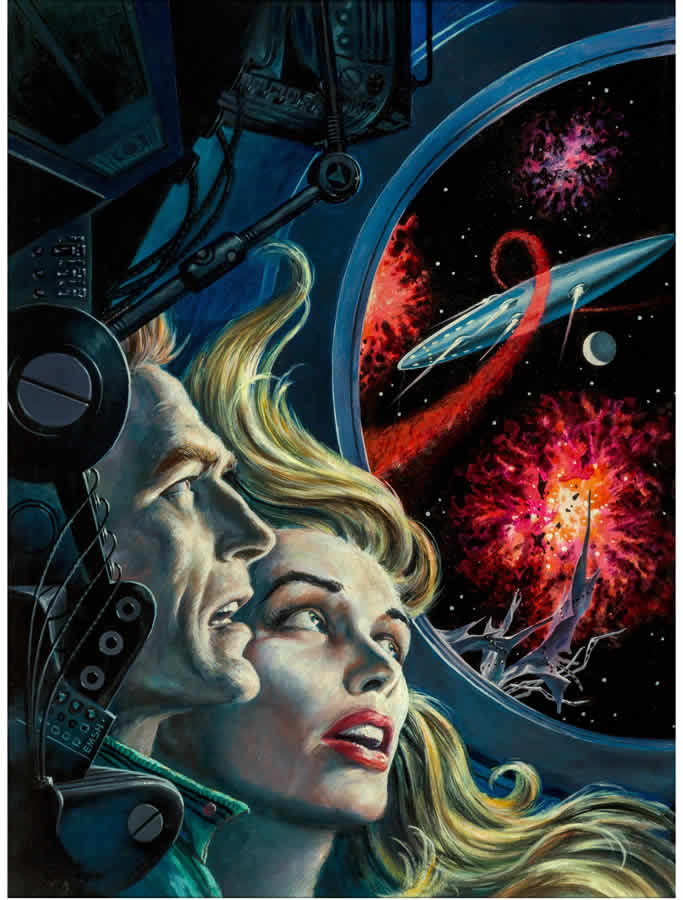
Space Station #1 paperback cover, 1957
Acrylic on board
Estimate: $8,000+
From the Glynn and Suzanne Crain Collection
Finally, what’s your advice to people who are interested in collecting science-fiction art today?
I would say identify what you really love, whether it’s a certain artist, a certain genre, paintings that were on the covers of certain authors’ stories. You figure out exactly what it is that attracts you. And then you go to conventions, you meet collectors, you network and get to know dealers and collectors in the field. It does take some groundwork. Somebody, maybe a friend or a fellow collector, will say, “I know a friend who’s selling this painting,” and you just have to network that way. That’s the best advice I can give … get out there and meet people, meet the collectors, meet the dealers and participate in the auctions and go to conventions. That’s how you put a collection together. It’s really the only way to do it.
HECTOR CANTÚ is editor of The Intelligent Collector.
This article appears in the Fall 2019 edition of The Intelligent Collector magazine. Click here to subscribe to the print edition.

